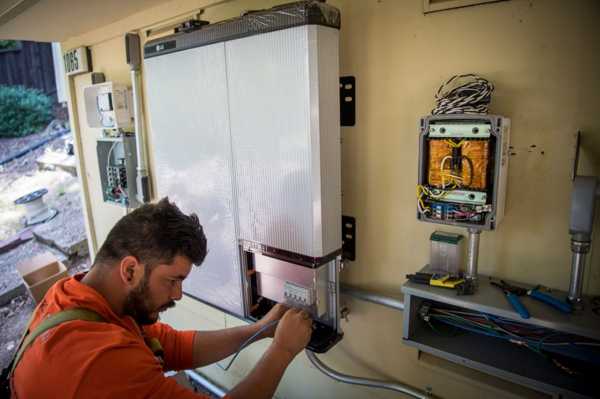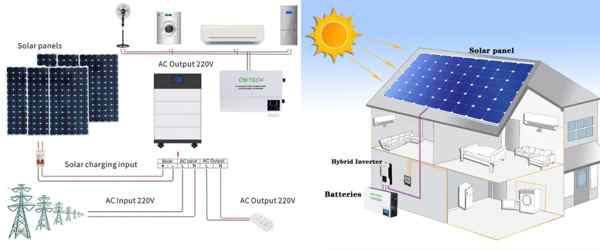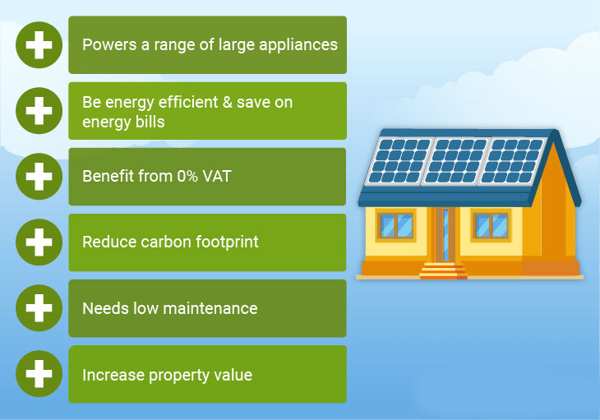كم من الوقت ستشغل بطارية 10 كيلو وات منزلي?
Considering a significant battery for your home and wondering just how much power a "10kW battery" can provide? You’re likely thinking about backup during outages or storing your solar energy, and it’s crucial to understand what that "10kW" really means and how long it will keep your lights on. The runtime of any battery, including a 10-kilowatt-hour system, depends entirely on your home’s energy consumption.
أولاً, let’s clarify a common point of confusion: "10kW battery." When we talk about how long a battery will last, we’re usually referring to its energy storage capacity, تقاس بالكيلووات/ساعة (كيلووات ساعة). A battery might also have a power rating in kilowatts (كيلوواط), which indicates how much electricity it can deliver at any one moment. For this discussion, we’ll assume we’re talking about a 10kWh battery unit, a common size for modern wall mounted battery storage systems. A 10kWh battery could theoretically power a continuous 1-kilowatt (1000دبليو) تحميل ل 10 ساعات, or a 500-watt load for nearly 20 ساعات (على افتراض أنه يمكنك استخدام طاقتها الكاملة, which is often possible with Lithium Iron Phosphate – LFP – technology).

في جيكس سولار, we specialize in designing solar energy systems paired with appropriately sized battery storage, often utilizing efficient and long-lasting LFP wall mounted battery units. Understanding your energy needs is the first step to determining how long a 10kWh battery, or any size, will truly serve you.
How big of a battery bank do you need to run a house?
Planning for energy independence or reliable backup power means figuring out the right size for your battery bank. How much storage capacity does your home actually require to keep things running smoothly during an outage or to power your home with solar energy overnight? Sizing it correctly is key to meeting your expectations.
The ideal battery bank size for a house varies significantly based on individual energy consumption habits, what appliances you want to power, and how long you need backup for. The average U.S. home uses about 25-30 كيلوواط ساعة من الكهرباء يوميا (مصدر: تقييم الأثر البيئي). لذا, ل full off-grid living or whole-home backup for an entire day, you might consider a battery bank in the 20-30kWh range or even larger. لكن, if you only want to power الأحمال الأساسية (مثل الأضواء, ثلاجة, إنترنت, الأجهزة الطبية) during an outage or overnight with solar, أ 10kWh to 15kWh system – perhaps one or two modern wall mounted battery storage units – might be perfectly sufficient.

الغوص أعمق: Tailoring Battery Capacity to Your Lifestyle
Here’s how we at Gycx Solar approach sizing a battery bank:
- Analyze Your Energy Consumption: We start by looking at your past electricity bills to understand your average daily and monthly kWh usage. We also discuss your typical appliance use. Do you have electric heating/cooling, an electric vehicle, a pool pump, or other high-draw appliances?
- Identify Critical vs. Non-Critical Loads: During an extended outage, what يجب stay on?
- Critical loads often include: Refrigerator/freezer, essential lighting, medical equipment (على سبيل المثال, CPAP machine), internet modem/router, well pump (إذا كان قابلا للتطبيق), and perhaps a furnace fan or minimal heating/cooling.
- Non-critical loads might include: Electric oven/stovetop, clothes dryer, central air conditioning (though some smaller AC units can be backed up), entertainment systems.
By focusing on critical loads, you can significantly reduce the required battery capacity for backup.
- Determine Desired Autonomy: How many hours, or even days, do you want your battery to last without any recharging (على سبيل المثال, from the grid or solar)? For grid-tied solar owners, often the goal is to cover overnight usage until the sun rises again. For off-grid systems, you might need 2-3 days of autonomy to cover cloudy periods.
- Factor in Solar Recharging: If you have a solar panel system (or plan to get one), your battery bank doesn’t necessarily need to hold multiple days’ worth of energy if your solar array can reliably recharge it daily. بطارية 10 كيلو وات ساعة, like a modern wall mount unit, can be fully recharged by a reasonably sized solar array during a typical sunny day.
- Consider Depth of Discharge (وزارة الدفاع) and Efficiency: Modern LFP batteries (common in wall mount storage) can often be discharged 80-100% من قدرتها المقدرة. We also account for round-trip efficiency losses (عادة 5-15%).
- Scalability of Wall Mount Battery Storage: Many wall mounted battery storage solutions, such as those offered by Gycx Solar, are modular. You might start with a 10kWh unit and find you can easily add another 5kWh or 10kWh module later if your needs increase. This provides excellent flexibility.
قصة GYCX الشمسية: We recently helped the Miller family size their system. They wanted to power their essential loads overnight using stored solar energy. After a load audit, we determined a 10kWh wall mounted battery unit was perfect. It covers their nighttime needs and recharges fully from their existing solar panels the next day, giving them great peace of mind and lower bills."
كم عدد الألواح الشمسية التي أحتاجها لبطارية 10 كيلو وات ساعة?
لذا, you’ve decided on a 10kWh battery – a great choice for significant energy storage, perhaps one of those sleek wall mounted units. الآن, how many solar panels do you need to effectively charge it each day so it’s ready to power your home when you need it? Proper solar array sizing is crucial for getting the most out of your battery investment.
لإعادة شحن أ 10كيلووات ساعة LFP1. (الفوسفات الحديد الليثيوم) بطارية على أساس يومي, you would typically need a solar panel array ranging from approximately 2kW to 3.5kW in size. This assumes you get an average of 4 ل 5 peak sun hours per day in your location and accounts for typical system efficiencies and losses. In terms of panel numbers, this could mean anywhere from 5 ل 9 modern high-efficiency solar panels (على سبيل المثال, panels rated between 350W to 450W each).

الغوص أعمق: Sizing Your Solar Array for Your 10kWh Battery
Here’s a breakdown of how we determine the right solar array size:
- Energy to Replenish Daily: بطارية 10 كيلو وات ساعة, if you’re using most of its capacity (على سبيل المثال, 90% Depth of Discharge – DoD for LFP), means you need to put back about 9 kWh of energy each day.
- ساعات شمس الذروة (PSH): This is the equivalent number of hours per day when the sun is at its peak intensity (1000 W/m²). This value varies significantly by geographic location and time of year. على سبيل المثال, sunny areas in the US might get 5-6 PSH, while less sunny or northern areas might average 3-4 PSH. We use local PSH data for accurate sizing.
- System Efficiency/Losses: Not all the power generated by your panels makes it into the battery. We account for:
- درجة حرارة لوحة الطاقة الشمسية (panels are less efficient when hot).
- Wiring and connection losses.
- MPPT charge controller efficiency (عادة 90-98%).
- كفاءة شحن البطارية (LFP is very high, غالباً >95%).
- Soiling, panel degradation over time.
A reasonable overall system efficiency factor to use in calculations might be 0.75 ل 0.85 (meaning 15-25% loss).
- الحساب:
Required Solar Array Power (كيلوواط) = Daily Energy Needed for Battery (كيلووات ساعة) / (عامل كفاءة النظام الذروة لساعات الشمس X)- مثال: If you need to replenish 9 كيلووات ساعة, يملك 4 ساعات شمس الذروة, and an efficiency factor of 0.80:
9 كيلووات ساعة / (4 الساعات العاشر 0.80) = 9 كيلووات ساعة / 3.2 = 2.81 كيلوواط (أو 2810 واتس)
- مثال: If you need to replenish 9 كيلووات ساعة, يملك 4 ساعات شمس الذروة, and an efficiency factor of 0.80:
- عدد اللوحات: Divide the required array power by the wattage of the panels you choose.
- If using 400W panels: 2810دبليو / 400W/panel ≈ 7 لوحات.
- إذا كنت تستخدم لوحات 350W: 2810دبليو / 350W/panel ≈ 8 لوحات.
- توافق الجهد: For a 48V nominal battery system (common for 10kWh wall mount batteries), the solar array must be configured (panels wired in series strings, and strings possibly paralleled) to provide a voltage that is significantly higher than the battery voltage but within the input limits of your MPPT solar charge controller (في كثير من الأحيان جزء من العاكس الهجين).
في GYCX Solar, we perform these detailed calculations to ensure your solar array is perfectly matched to your 10kWh wall mounted battery storage, maximizing its charging efficiency and your energy independence.
Do you need 3 phase for 10kW solar?
If you’re planning a substantial 10kW solar panel system, perhaps to charge your new 10kWh battery and cover significant household or business loads, you might wonder if your existing electrical service needs an upgrade – specifically, do you need three-phase power for a solar array of this size?
عمومًا, ل residential 10kW solar system in the United States, you do not need three-phase power. Most homes in the U.S. are supplied with single-phase electricity, and modern single-phase solar inverters are readily available and perfectly capable of handling 10kW, or even slightly more (some models go up to 11.5kW, 15كيلوواط, أو حتى أعلى). لكن, utility interconnection rules can vary, and for very large residential properties or commercial buildings that already have three-phase service, a three-phase solar system might be considered or required, especially for systems significantly larger than 10kW.

الغوص أعمق: Understanding Power Phases and Solar Systems
دعنا نوضح:
- Single-Phase Power: This is the standard electrical service for most homes and small businesses in the U.S. It typically provides 120V for lighting/outlets and 240V for larger appliances.
- Three-Phase Power: Provides three alternating currents that are offset in phase. It’s more efficient for running large motors and heavy machinery, so it’s common in commercial and industrial facilities. Some very large or custom homes might have it, but it’s rare.
- Inverter Capability: The key component is the solar inverter. There are many high-quality single-phase string inverters and microinverters available that can support a 10kW solar array. Hybrid inverters designed to work with systems like 10kWh wall mounted battery storage are also commonly single-phase for residential use and can handle this solar capacity.
- Utility Interconnection Standards: Each utility company has its own rules for interconnecting solar systems to their grid. While most allow up to 10kW (and often more) of single-phase solar, it’s always crucial to check their specific requirements and go through the proper application process. أحيانا, for very large single-phase systems, they might require specific studies or equipment.
- When Would 3-Phase Solar Be Used?
- If the property already has three-phase electrical service (common for commercial buildings).
- For very large solar installations (typically well above 10-15kW residential, or for commercial/industrial scale) where a three-phase inverter offers better efficiency and grid interaction.
- Cost of Upgrading Service: Converting a home’s electrical service from single-phase to three-phase is a major, very expensive undertaking and is almost never done just to accommodate a 10kW solar system. It’s far more practical to use a suitably sized single-phase inverter.
Is it worth getting a 10kW solar system?
You’re looking at a 10kW solar panel system, perhaps to charge that 10kWh wall mounted battery and significantly offset your electricity bills. It’s a sizable investment, so the big question is: Is it truly worth it? For many homeowners and small businesses, a 10kW system represents a powerful and often financially rewarding step towards energy independence.
نعم, في معظم الحالات, أ 10kW solar system is well worth the investment, especially for homes or small businesses with moderate to high electricity consumption. Such a system can drastically reduce or even eliminate your monthly electricity bills, offer an attractive Return on Investment (عائد الاستثمار) – particularly when factoring in incentives like the Federal Solar Investment Tax Credit (مركز التجارة الدولية) – provide greater energy independence, significantly lower your carbon footprint, and enhance your home’s value. When paired with battery storage, مثل 10kWh wall mounted battery unit, its value increases even further by enabling backup power and maximizing the use of your self-generated solar energy.

الغوص أعمق: The Value Proposition of a 10kW Solar System
A 10kW solar system is a significant energy producer. Here’s why it’s often a smart choice:
- Substantial Energy Production: Depending on your geographic location and local climate (average sun hours), a 10kW solar PV system can generate approximately 11,000 ل 17,000 كيلووات ساعة (كيلووات ساعة) of electricity per year (مصدر: NREL PVWatts calculator). This is enough to cover the entire annual electricity usage of many average American homes, or a significant portion for larger homes or small businesses.
- Financial Returns:
- Drastically Reduced Electricity Bills: This is the most immediate and tangible benefit.
- Attractive ROI & فترة الاسترداد: While upfront costs can be significant, the long-term savings on electricity often result in payback periods of 5 ل 12 سنين (highly variable by location, معدلات الكهرباء, and incentives). After payback, the energy is essentially free.
- ائتمان ضريبة الاستثمار الشمسي الفيدرالي (مركز التجارة الدولية): حالياً, this allows you to deduct 30% (or more with certain domestic content/energy community adders) of the total system cost (including a paired battery like a 10kWh wall mount unit if it’s charged by solar) from your federal taxes, making the investment much more affordable (مصدر: نحن. وزارة الطاقة).
- الحوافز الحكومية والمحلية: Many areas offer additional rebates, tax credits, or performance-based incentives (like SRECs in some states).
- Hedge Against Rising Utility Rates: Lock in your energy costs for decades.
- Enhanced Benefits with Battery Storage (على سبيل المثال, a 10kWh Wall Mount Unit):
- Maximize Self-Consumption: Store excess solar energy produced during the day (instead of sending it all to the grid, especially if net metering isn’t highly favorable) and use it at night or on cloudy days.
- الطاقة الاحتياطية: Provides power to your essential loads (or whole home, depending on system design) أثناء انقطاع الشبكة, offering security and peace of mind.
- Increased Energy Independence: Rely less on the utility grid.
- التأثير البيئي: Significantly reduces your household’s or business’s carbon footprint by generating clean, طاقة متجددة.
- Ideal Candidates: عادة, a 10kW system is a good fit for homes with monthly electricity bills exceeding $150-$200, those with high daytime energy use, owners of electric vehicles, or anyone seeking substantial energy independence and backup capabilities, especially when paired with a 10kWh or larger battery.
في GYCX Solar, we frequently design 10kW solar systems coupled with our efficient wall mounted battery storage الحلول. We provide personalized analyses to show you exactly how such a system can meet your energy goals and what financial returns you can expect.
بطارية 10 كيلو وات ساعة, especially in a modern wall mounted storage unit, can provide significant backup power and enhance your use of solar energy. Understanding how long it lasts, how to size the right solar array to charge it, and the overall value of such a system are key to making a smart investment in your energy future.
If you’re considering a 10kWh battery, a 10kW solar system, or a complete wall mounted battery storage solution, the experts at Gycx Solar are here to help. We can answer your questions and design a system perfectly tailored to your needs. Contact us today to start your journey towards energy independence!
Understand the concept of Lithium Iron Phosphate in order to better compare and understand the data concepts associated with lithium batteries. This will help you select a product that better suits your needs. ↩
